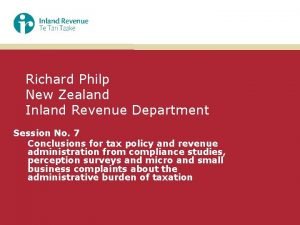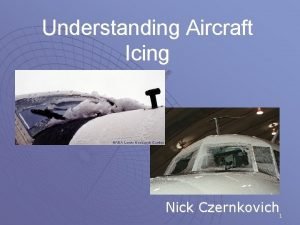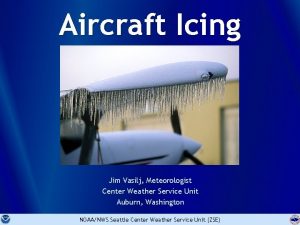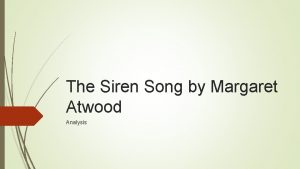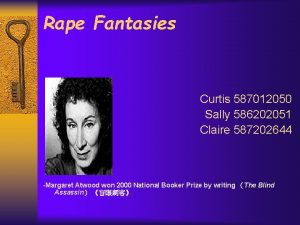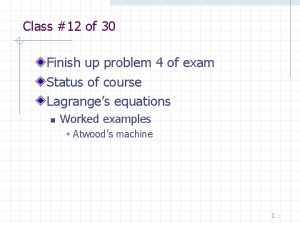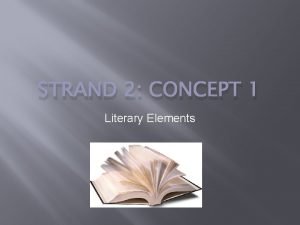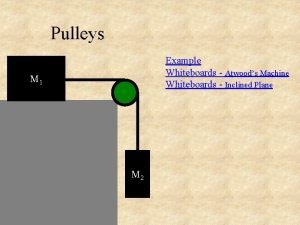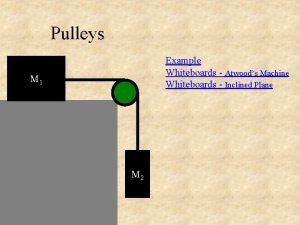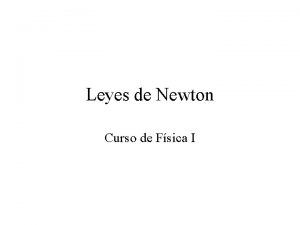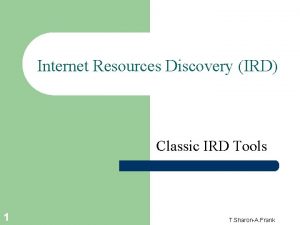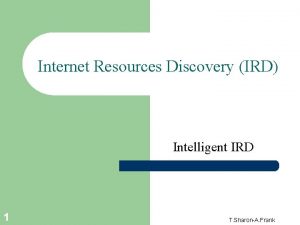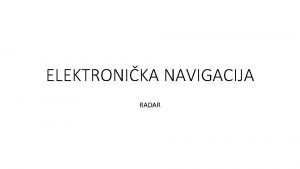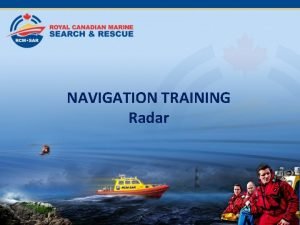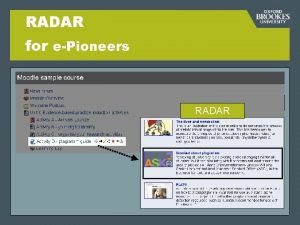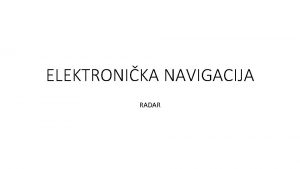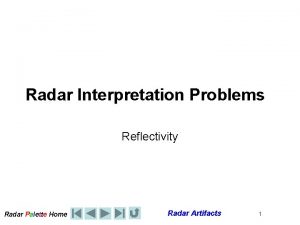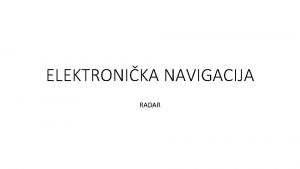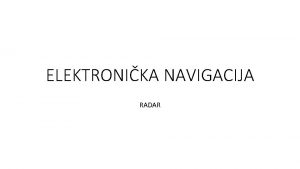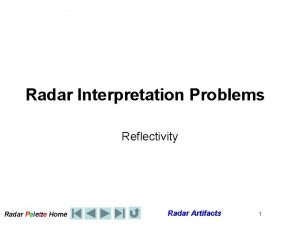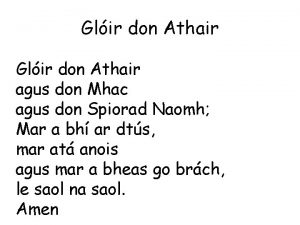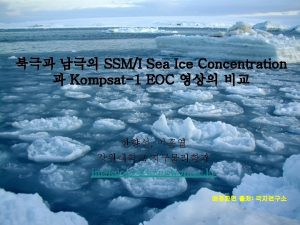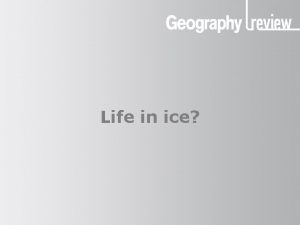SteppedFrequency Ice Radar Don Atwood Ice Radar IRD


















- Slides: 18

Stepped-Frequency Ice Radar Don Atwood

“Ice Radar” IR&D Project Goal: Investigate the use of radar systems for identifying and characterizing the motion of ice • Use Akela stepped-frequency radar • Employ interferometric coherence to identify ice, land, and water • Use phase to determine ice velocity Two experiments conducted: • 4 April : Grand Haven Harbor Entrance • 4 -7 May : Keweenah Waterway, Houghton

Akela RF Vector Signal Generator Emission – Stepped Frequency Continuous Wave (SFCW) Frequency Range – 500 MHz to 6 GHz Frequency Hopping Rate – 14 user selectable options, 20 to 90, 000 per second Power Input – 12 watts nominal Power Output – 17 d. Bm nominal Size – 4. 25″ x 7. 5″ x 1. 5″, 1. 1 lbs Communications Interface – 10/100 Base T Ethernet Software Interface – Lab. VIEW

Grand Haven Experiments • Grand Haven (on shore of Lake Michigan) chosen for availability of near-shore ice • Ice present at end of channel and along-shore to south of pier Images acquired by Go. Pro camera on Phantom UAV

Grand Haven Experiments • Akela deployed beach side (Site #2) of jetty

Grand Haven Akela Experiments Band (GHz) 1 -6 1 -3 3 -6 1 -2 2 -3 3 -4 4 -5 5 -6 2 -3 # Frequencies Hopping Rate Sweep PRF (Hz) Max. Range (m) Resolution (m) Numscans Label 4000 15, 300 3. 8 120 0. 03 462 wideband_girl 4000 15, 300 3. 8 300 0. 075 462 narrowband_girl 4000 15, 300 3. 8 200 0. 05 462 narrowband_girl 2 4000 15, 300 3. 8 600 0. 15 462 narrowband_1_2 4000 15, 300 3. 8 600 0. 15 462 narrowband_2_3 4000 15, 300 3. 8 600 0. 15 462 narrowband_3_4 4000 15, 300 3. 8 600 0. 15 462 narrowband_4_5 4000 15, 300 3. 8 600 0. 15 462 narrowband_5_6 4000 45, 000 11. 25 600 0. 15 1362 narrowband_5_6_45 k 4000 45, 000 11. 25 600 0. 15 1362 narrowband_2_2_45 k

Processing the Akela Radar (Part 1) 1. 1 D FFT to convert stepped frequency data into Range vs. Slow Time 2. Create Pulse-pair Interferogram

Preliminary Akela Results • Near-shore ice and “movers” seen in image • Constant phase versus slow time indicates stationary targets • But small range bins (3 -15 cm) and low PRF (3. 8 Hz) are ill-suited for velocity estimation. • Rapid motions are not seen in phase. Interferometric Magnitude (left) and Phase (right) for Narrowband_1_2

Houghton Experiments • Houghton chosen for availability of moving ice and good working environment atop the Great Lakes Research Center • Akela deployed during passage of ice

Houghton Experiments • Experiments coordinated with U. S. C. G. breaking ice in Keweenah Waterway • Coast Guard broke the ice and an East wind blew the ice down the waterway

Houghton Akela Experiments Band (GHz) 1 -2 2 -3 3 -4 4 -5 5 -6 # Frequencies Hopping Rate Sweep PRF (Hz) Max. Range (m) Resolution (m) Numscans Label 2000 30, 000 15 300 0. 15 462 glrc_1_2 2000 30, 000 15 300 0. 15 462 glrc_2_3 2000 30, 000 15 300 0. 15 462 glrc_3_4 2000 30, 000 15 300 0. 15 462 glrc_4_5 2000 30, 000 15 300 0. 15 462 glrc_5_6

Processing of Akela (Part 2) • Alternative to more typical Pulse-Pair Interferogram • Use: • Interferometric Coherence to distinguish between ice and water • Interferometric Phase to monitor time-evolving velocity Start with Range-compressed Akela “image”

Coherent Processing of Akela (Part 2) Step #1 Create a stack of N complex (I&Q) Akela range-compressed “images” • Each successive layer displaced one frequency sweep to the left. • Third dimension of complex array now represents N sequential time slices Slow-time Axis Step #2 Drilling up through each pixel, unwrap phase and perform linear regression on phase. “Slope” is used to compute Instantaneous LOS Speed Step #3 Use slope to remove phase gradient for each pixel. Slow-time Axis

Coherent Processing of Akela (Part 2) Range Slow-time Axis

Akela Results Coherence delineates between water (low coherence) and ice/land (high coherence)

Akela Results Result validation: Ice passing GLRC pier was clocked at ~4 cm/sec

Akela Results Coherence and Speed results for data taken at later time (with increasing ice coverage spanning the waterway)

Conclusions • Akela Radar is well-suited for short-range applications (such as the Waterway), but low PRF may limit longer range applications • Any Akela application in the Arctic would require weatherization effort • Interferometry provides an alternative approach to Real-aperture Radar, providing the means to both identify non-water targets and characterize the speed of movers
 Ird library
Ird library Digital library
Digital library Richard philp
Richard philp Pulse doppler radar vs mti
Pulse doppler radar vs mti Delay line canceller in radar
Delay line canceller in radar Taking things that don't belong to you
Taking things that don't belong to you Tat sat temperature
Tat sat temperature Clear ice vs rime ice
Clear ice vs rime ice Siren song margaret atwood theme
Siren song margaret atwood theme Atwood's classification of residual ridges
Atwood's classification of residual ridges Rape fantasies by margaret atwood
Rape fantasies by margaret atwood Atwood machine lagrangian
Atwood machine lagrangian Habitation by margaret atwood analysis
Habitation by margaret atwood analysis Margaret atwood the moment
Margaret atwood the moment Atwood machine on inclined plane
Atwood machine on inclined plane Atwood's machine tension
Atwood's machine tension Indirect sequelae of wearing complete denture
Indirect sequelae of wearing complete denture Margaret atwood, ‘the city planners’
Margaret atwood, ‘the city planners’ Diagrama de cuerpo libre
Diagrama de cuerpo libre


